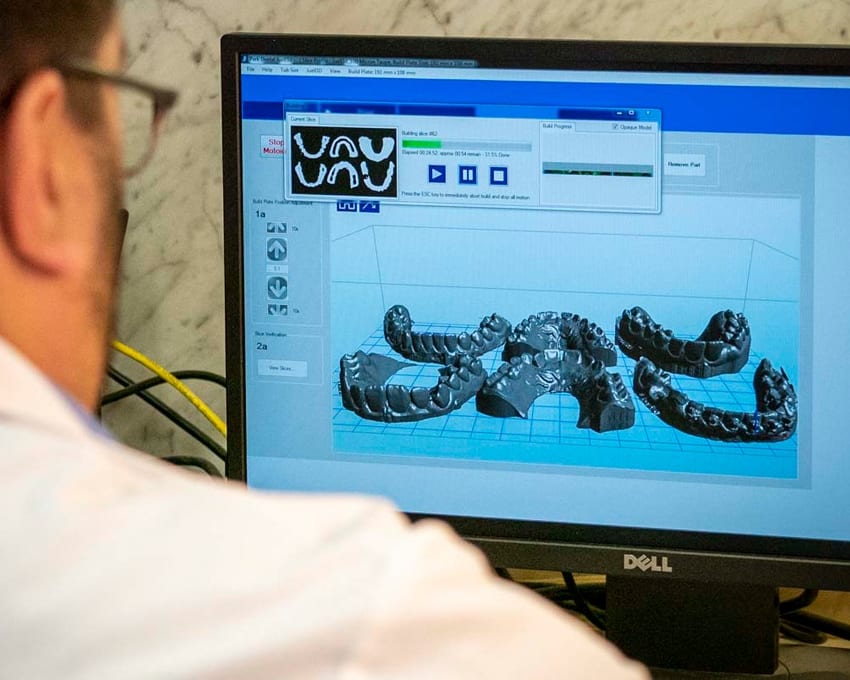Our orthodontists at Vincelli Orthodontics offer a wide selection of orthodontics services for children, teens and adults, to help keep their smiles healthy.

How Orthodontics Work
Are your teeth crowded or misaligned? Our orthodontists see many patients with misaligned teeth.
These conditions can include crossbite, overbite, overjet and crowded teeth - and the problem is not just aesthetic. A bad bite can also lead to numerous oral health problems.
Whether we are working with children, teenagers or adults, the goal of orthodontic treatment is the same - to straighten teeth so they look better and work better.
This goal can be achieved using braces or clear aligners that apply gentle pressure to your teeth and move them into the correct position over a period of months or years, leaving you with a more even smile.
Orthodontic treatment can also help address issues related to chronic pain, TMJ Disorder and sleep apnea.
Traditional Braces
Made of metal, traditional braces have been used for decades to straighten teeth. In recent years, advances in orthodontic treatment have resulted in braces that are low-profile, easier to care for and more comfortable.
Braces put continuous pressure on teeth over a period of time, gradually moving them to their new, corrected positions. The bone changes to accommodate the new positions of the teeth as pressure is applied and the teeth shift.
Invisalign Clear Aligners
Invisalign clear aligners can gradually straighten your smile using a series of individually customized, clear plastic aligners that are adjusted over a period of time.
If you'd prefer that no one know that you are straightening your teeth, Invisalign clear aligners offer a built-in convenience factor in that they're removable. Similar in appearance to custom whitening trays, they are easy to insert. You can even remove them to brush, floss, eat and drink.
Treatable Orthodontic Conditions
There are a number of malocclusions (misalignments) of the teeth and jaws that can be treated with braces or clear aligners.
Your orthodontist will perform a comprehensive clinical evaluation of your jaw and mouth in order to determine your smile's nature and severity, then customize a treatment plan to fit your unique needs.
-
Crowding
One of the most prevalent orthodontic problems is teeth that are too crowded. Crowded teeth are extremely difficult to clean, making them more prone to decay, even if good oral hygiene is practised.
-
Spaces in Teeth
Spaces in teeth can be a problem, especially if the early loss or extraction of teeth causes healthy teeth to tip into open spaces. Deterioration of the supporting bone may occur, causing teeth to become loose.
-
Overbites
This can cause abnormal wear of tooth surfaces, as well as excess stress on supporting bone and gum tissue. The stress on supporting tissues might contribute to gum disease and possibly lead to the loss of teeth.
-
Underbites
An underbite is a term for a dental condition characterized by lower teeth that extend outward farther than the upper front teeth. Severe cases of underbite may cause difficulty biting and chewing food, challenges with speaking and mouth and face pain due to the misalignment of the jaw.
-
Crossbite
A crossbite is a misalignment of teeth, usually where the upper teeth fit inside the lower teeth. This misalignment can affect a single tooth or groups of teeth. If not corrected, a crossbite can wear down the enamel of the tooth as the jaw.
-
Sleep Apnea
Sleep Apnea can happen when the airway is obstructed by any or all of the tonsils, adenoids, nasal obstruction, and tongue (not enough room because of narrow or receded jaws). At night, the body has to “fight” to get air past the obstructions. Cortisol, a stress hormone, is produced to create the fight to breathe.
Sleep Apnea may cause long-term high levels of cortisol which may have negative effects. It can happen at all ages.
Sleep Apnea and symptoms of Sleep Disordered Breathing can be helped with orthodontic treatment.
-
TMJ Disorder & Chronic Pain
Many adults and teens experience pain because of Temporomandibular Disorder (TMD), and “bad bites” are often a contributing factor to TMD. Jaw dislocation is what causes all of the symptoms that the patient experiences.
Orthodontic Treatment for All Ages
Learn more about how our treatment options work for children, adults and teens.
